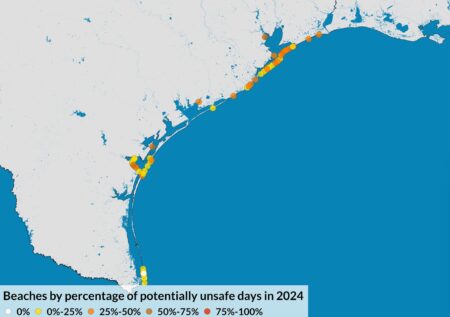A recent and concerning report has unveiled alarming levels of bacterial contamination across numerous Texas beaches, raising significant public health and environmental safety concerns for swimmers and recreational enthusiasts. This comprehensive analysis highlights the persistent challenges faced by coastal regions in maintaining safe water quality standards amidst increasing environmental pressures and public usage.
Specifically, the report detailed that a staggering ninety-four percent of the sixty-three Texas beaches subjected to testing in 2024 showed positive results for unsafe concentrations of fecal matter in their waters. This widespread contamination points to a systemic issue affecting the state’s popular coastal destinations, threatening the well-being of countless visitors drawn to its shores annually.
Further compounding the problem, thirty of these impacted beaches recorded bacterial levels that exceeded safety benchmarks on at least twenty-five percent of all days they were tested throughout 2024. This consistent presence of pollutants suggests ongoing sources of contamination, making these particular locations potentially hazardous for extended periods and underscoring the urgency of corrective measures for Texas beaches.
The benchmark for water safety, as established by the Environmental Protection Agency (EPA), is referred to as the Beach Action Value (BAV). This crucial standard indicates an unsafe level when bacteria concentrations surpass thirty-two illnesses per one thousand swimmers, serving as a critical threshold to protect public health during recreational activities.
Elevated levels of fecal bacteria in water bodies are a clear indicator of potential pathogens that can cause a range of gastrointestinal illnesses, skin infections, and respiratory problems. For individuals who come into contact with or ingest this contaminated water, the risks to their public health are considerable, necessitating vigilant monitoring and clear public advisories.
While the findings for Texas are particularly stark, the issue of water quality is not isolated to the Lone Star State. Nationally, the report found that sixty-one percent of beaches across the United States experienced at least one day in 2024 when fecal matter reached unsafe levels, underscoring a broader challenge in maintaining beach safety standards countrywide.
Sources of this bacterial contamination can be diverse, ranging from stormwater runoff carrying animal waste and agricultural runoff to failing septic systems and wastewater treatment plant overflows. Identifying and mitigating these sources is crucial for improving water quality and safeguarding ecosystems, demanding concerted efforts from local and state authorities.
The report serves as a critical call to action for stakeholders, policymakers, and the public alike to address the persistent issue of polluted waters. Ensuring cleaner, safer beaches for everyone requires ongoing investment in infrastructure, stricter enforcement of environmental regulations, and increased environmental safety awareness to protect both natural resources and human health.






Leave a Reply